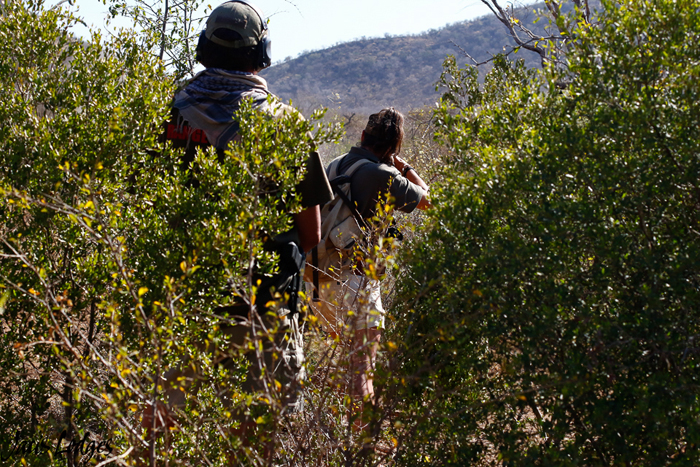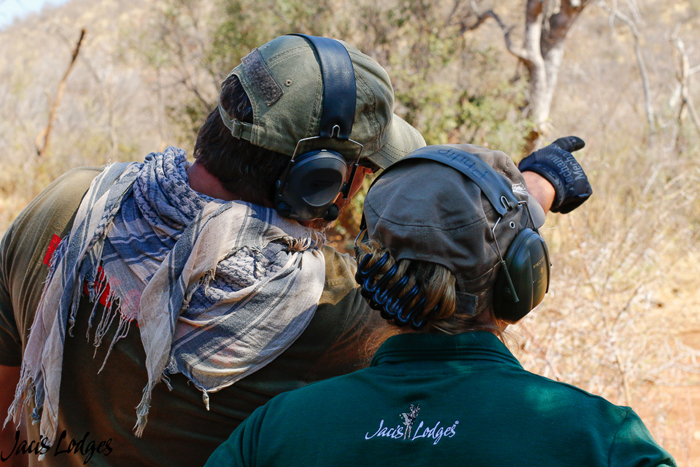Walking safaris are a popular activity to do whilst in the bush, they do however come with an element of danger. Did you know in order for guides to lead walks in Madikwe they have to pass “Bush Lane” first? Madikwe Game Reserve guides have to prove themselves competent when it comes to rifle shooting just in case that rare occasion arises, so a few times each month they hold training and evaluations at the two shooting ranges in the reserve.
Training is taken very seriously and guides are expected to be on top form. You need to be able to place at least three out of four shots within a 12cm diameter circle, at a distance of 30metres, as well as shooting three targets at 30, 20 and 10 metres, respectively, within 15 seconds. To be able to lead bush walks, you need to up your game and pass the Bush Lane assessment as well, which is arranged three/four times a year in Madikwe. If you pass, it means you are able to lead bush walks in the reserve for the coming year. I am always proud that we have such high safety standards.
Bush Lane normally takes place over a few days, as there are many guides that need to be slotted in, mostly in between game drives and walks, as most of us are still working our regular hours as well. Hence the hours between ten and two, in the heat of the day, are the most popular and hectic. Guides who are on leave or don’t have guests can choose to shoot in the early mornings, before it gets dreadfully hot. About six-eight assessments per day can be conducted, while the 30m groupings and 30, 20, 10 evaluations will also be done.
The guides who are qualified to conduct the assessments, as well as a few hang-arounds helping out with the logistics, camp out at the location for the duration of Bush Lane. Normally a few of the newer guides in the reserve will volunteer to do this, entailing going with on each assessment, carrying ammunition, picking up spend cases, replacing targets, as well as cooking, cleaning up, digging a long-drop, doing all sorts of maintenance, etc. It is very hard work in blazing heat and for long hours, but also rather rewarding and it’s a great way of getting to know a lot of the guides in the reserve, not to mention that if you do a decent job, you have proven yourself to the whole of the reserve.
If you’re visiting Bush Lane or doing your assessment, rule number one is to bring ice! Camping out for a few days without electricity makes it difficult to keep food and liquids cold and fresh, so ice is naturally vital. One day two of the girls even brought ice cream from the general dealer an hour away, packed in lots of ice… what a treat in the 35ºC heat!
Bush Lane will take you about an hour or so and you start off with your pre-trail brief, going through safety, hand signals, what to do and not to do on a walk. You need to make sure you’ve brought your First Aid kit, water and other necessities. The first exercise is a timed, blind-folded loading of your rifle. Once this is completed you can start the simulated walk. As you walk on the game paths, through thickets and drainage lines, moving animal targets (controlled by the assessor) may pop up any moment. You need to be prepared, but at the same time walking at normal Sunday stroll pace, not in hunting mode.
Some scenarios involve only one and others multiple dangerous game targets, at varying distances. To avoid total carnage, you can use a maximum of two rounds per target. Not only do you need to be accurate with your shot placement and consider safety at all times, but also make sure you’re aware of how many rounds you’ve fired, so that you don’t try to fire without any rounds left, or trying to load too many rounds into your rifle. You also have to make sure you don’t drop any rounds, keep your group in check and keep an eye out for non-threatening animals, that aren’t supposed to be shot (like zebra and monkey targets), just to test your observational skills.
Because there’s always a few much more experienced people walking with you on the assessment, and there are quite a number of targets popping up out of nowhere, there’s a lot of pressure and stress involved. Even the more experienced guides and better shots in the reserve find it nerve wrecking and may get flustered and intimidated, which (I guess) is part of the point. You know there won’t be any real lions charging you, so the added stress of other guides scrutinising your every move and the sheer number of targets at least gets your adrenalin pumping and goes a little bit towards simulating the real stress you’d be under if a real charge would ever happen. You also know that if you don’t pass, you’ll not be able to fulfil a part of the job you probably were hired to do, taking guests on walks… and there may be three-four months until your next evaluation. This is why most lead trails guides try to come around more than once a year, so that this hopefully won’t happen.
As the sun starts to set and the heat dispatches, shooting stops. A fire is re-started and cooking commences, while everyone takes a stand-by for the much needed bush shower. It is always amazing how great anything tastes, cooked on a fire in the bush, roast chicken, chilli con carne, beef potjie… you name it. As it normally takes a few hours for the food to be prepared, there’s plenty of time for catching up with friends you may not meet too often while working and sharing stories around the fire. Going to bed while hyenas are whooping in the distance and branches are breaking nearby is something I never get tired of. The only thing disturbing the peace is the horrific snoring of a few of your colleagues.
/A





No comments:
Post a Comment